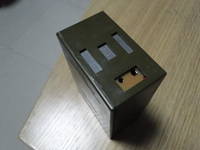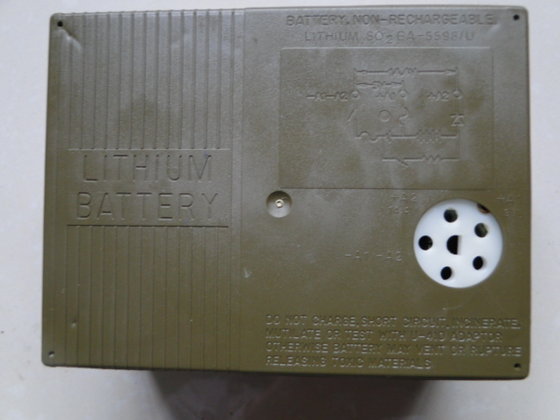

 |
 |
|
|
|
#1
|
|||
|
|||
|
I've been having a bit of give and take with one of the players regarding his thermal sight. I know those things are pretty small now, but I always have the image of this guy in my head from the old US Vehicle guide.
Is that thing a thermal sight? And what should I be looking at as a period piece of technology. By which I mean, a 2000 era item envisioned in 1980 something. Thanks, Chris
__________________
Blogging the current FtF I'm running at http://twilight-later-days.blogspot.com/ Everything turns into Cthulhu at the end. |
|
#2
|
||||
|
||||
|
Well frist off I don't think that is a thermal sight, it looks like AN/TVS-5 Night Vision Sight which is a night vision sight for heavy weapons like the 50 Cal
For Thermal sights in the TW2000 era your the US has AN/PAS-13 which I think would be in service in the war, IRL the sight came on line in 1998, I don't it too much of stretch to production and feilding moved up.
__________________
I will not hide. I will not be deterred nor will I be intimidated from my performing my duty, I am a Canadian Soldier. |
|
#3
|
||||
|
||||
|
Starlight scopes were in use during the Vietnam war; the M3 Sniper System was a backpack-carried power-source and processing source (in the sense that it did all the heavy lifting, not in that it provided any kind of computerized synthetic vision) for an IR scope fitted to the M1 Carbine. It was a bulky system but the rifle's effective range was about the same as the scope's night-vision capabilities so it was actually fairly decent.
I could foresee a county SWAT team out in the sticks finding them very useful post-apocalypse. http://www.imfdb.org/wiki/Talk:M1_Carbine |
|
#4
|
||||
|
||||
|
Chris, sorry this is a long read but here is some info on 1990s imagers and a few webpages regarding the development of night vision systems (including thermal imagers). Your player should probably read those webpages too. The following is info from various books and websites but also my own personal experience with thermal imagers in the early 1990s with the Australian Army.
Thermal imagers of the 1980s and 1990s were big bulky things commonly found only mounted in vehicles or on tripods. They required coolant gases to increase their heat sensitivity which meant they required several seconds of "cool down" time before they could be used. Thermal Weapons Sights for small arms were in the early stages of development and production and were scarce in military service (they were incredibly expensive, somewhat fragile and there just weren't that many made at the time to allow widespread distribution) It was not until the mid-late 1990s that the FPA (Focal Plane Array) allowed thermal imagers to get small enough for widespread use and the technology was actually pushed forward by commercial applications (police, fire, rescue and security) rather than military. For the Twilight War, those commercial demands are highly unlikely to exist so the research that lead to the FPA would be in its infancy at best. Someone mentioned the AN/PAS-13, it's a hell of lot handier than earlier generations of thermal imager but unfortunately it didn't come into service until the late 1990s (I think it was 1997 or 1998). My ruling would be that if your player has a thermal imager for a weapon sight and you have the Twilight War starting before the late-1990s, then it's probably a Hughes Thermal Weapon Sight (TWS) or a Magnavox Short-Range Thermal Sight (SRTS) - either way, it's big, it's bulky, it makes a high pitched whining noise like a mosquito when it's operating, it's only able to display in green, white and black, it uses unique batteries and it's heavy, like several kilograms heavy. And the player should consider it to be rarer than rare and should feel blessed that they have such a high-tech piece of gear! http://www.nvl.army.mil/history.html This is a US government run site and they have a strict "if you use this site expect us to check you" kind of warning at the start. http://www.strategypage.com/dls/arti...-3-18-2011.asp http://www.thermal-eye.com/about_us/index_history.htm This page has a short history of thermal imaging development. Note that L-3 Infrared Products was formerly Raytheon Commercial Infrared so they're a defence industry company. http://www.globalsecurity.org/milita...-22-9/apph.htm This page is from one of the US Army manuals and it deals with night fighting - long but worth a read for the different aspects of aided and unaided night viewing. Some basic specs for the two thermal sights I mentioned: Hughes TWS - Light Weapon Thermal Sight (for rifles & carbines) Weight: 1.7kg Effective Range; 550m Battery Life: approx 10 hours* Hughes TWS - Medium Weapon Thermal Sight (for GPMGs) Weight: 1.9kg Effective Range; 1100m Battery Life: approx 8-10 hours* Hughes TWS - Heavy Weapon Thermal Sight (for HMGs, Mk19 AGL, sniper rifles) Weight: 2.1kg Effective Range; 2200m Battery Life: approx 8 hours* Magnavox SRTS Weight: 1.8kg Effective Range; 550-600m* Battery Life: 10 hours * = estimated (I haven't got any solid data, just some estimated figures from a 1993 source) |
|
#5
|
||||
|
||||
|
How do you recharge a thermal site in T2K? Questions in two parts;
1. what sort of connection is it? 3 pin 240 volt? USB? Proprietry type cable? 2. What power source could you use? Diesel generator? Battery pack?
__________________
"Beep me if the apocolypse comes" - Buffy Sommers |
|
#6
|
||||
|
||||
|
Quote:
I guess the designers figured the game was tough enough without having to scrounge for batteries ALL the time so they decided that everything was rechargeable. As for the thermal imagers, many of them used disposable lithium cells set up in series and packaged inside a case such as the BA 5847 U battery pack shown below (note that the connector from the thermal imager is a two pin plug that plugs into the battery and that this battery weighs 0.38kg).   Some older batteries used a 6-pin connector (one is actually just a locating pin and these packs are referred to as using a 5-hole connector) such as that found on the BA 5598 battery shown below.  And the same type of connector is used on the BA 4386 U battery pack - those of us who've lugged a Prick 25 or 77 know these ones!  There is some hope for Twilight PCs however as some thermal weapon sights also had a standard military power connection to hook up the device to an external 6-24V DC power source. Plus many of the Western military lithium battery types have 6 to 10 year shelf life. Later developments made some of these batteries rechargeable, there's a rechargeable version of the BA 4386 U battery pack, but I don't know if these would be available in time for the Twilight War. |
|
#7
|
||||
|
||||
|
Quote:
Keep in mind this is mid-90s tech. Or you can go with what was experimental tech for the time, issued to sniper teams, LRSU teams, and the various special ops types: A solar panel (from 3x3 to 5x5 and anywhere in between) with connectors to various battery or battery chargers (for small batteries). A 3x3 will supposedly charge a SINCGARS battery in less than an hour. And I imagine they have better stuff now. I'm even considering buying a small solar panel and some holding batteries, since I can't afford to put solar panels and wind turbines on my roof... 
__________________
I'm guided by the beauty of our weapons...First We Take Manhattan, Jennifer Warnes Entirely too much T2K stuff here: www.pmulcahy.com |
|
#8
|
||||
|
||||
|
Quote:
|
|
#9
|
||||
|
||||
|
dont know what help it will give you - the Norwegian forces had thermal sight son their Leopard 1a5 tanks from the early 90s. Dont remember the make.
We did get to see one "dismounted" - on a tripod with a battery pack the size of a suitcase. I had to laugh when I saw that a standard issue foam sleeping mat actually hid the trooper underneath. ( But it did come through as a square shape in the sights though..) |
|
#10
|
||||
|
||||
|
Quote:
That answers a question I'd had about a Twilight Zone episode. Guy on was a Navy lifer who'd served on a sub in the south pacific and had survivor's guilt because he was the only crewman to survive a Japanese attack after he'd accidentally knocked an "IR filter" off of a searchlight prior to the boat submerging. For years I thought "oh well the writers were just throwing out a cool technical term they heard somewhere, only the Germans had IR gear back then..." 'course I dunno if the Navy did but it's at least plausible now 
|
|
#11
|
||||
|
||||
|
Quote:
Alternatively, you could try such terms as military lithium battery and military battery. They return a lot of hits then you have to sort through everything  Quote:
|
|
#12
|
||||
|
||||
|
AFAIK, it didn't show up in the Pacific until June or July, so it got very limited use in WWII. It was used in Korea, but I don't remember it's operatioanl history there.
I think there were three different configurations )at least one mounted the IR scope over the receiver, another under the barrel and one used a vertical fore-grip (this made some sense as the M-3 was selective fire like the M-2) The Gear added weighed as much as the carbine had by itself. |
 |
| Currently Active Users Viewing This Thread: 1 (0 members and 1 guests) | |
| Thread Tools | Search this Thread |
| Display Modes | |
|
|